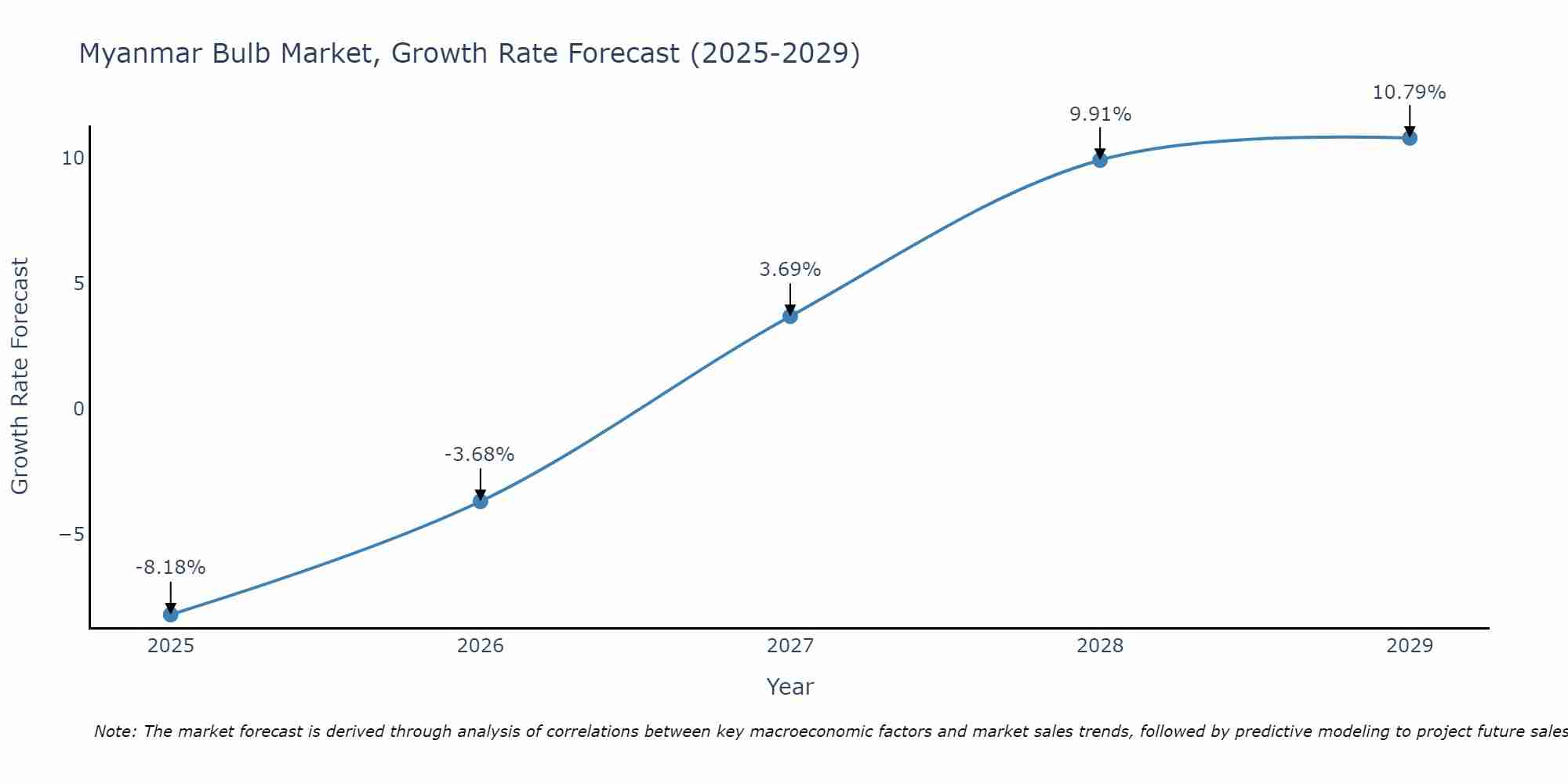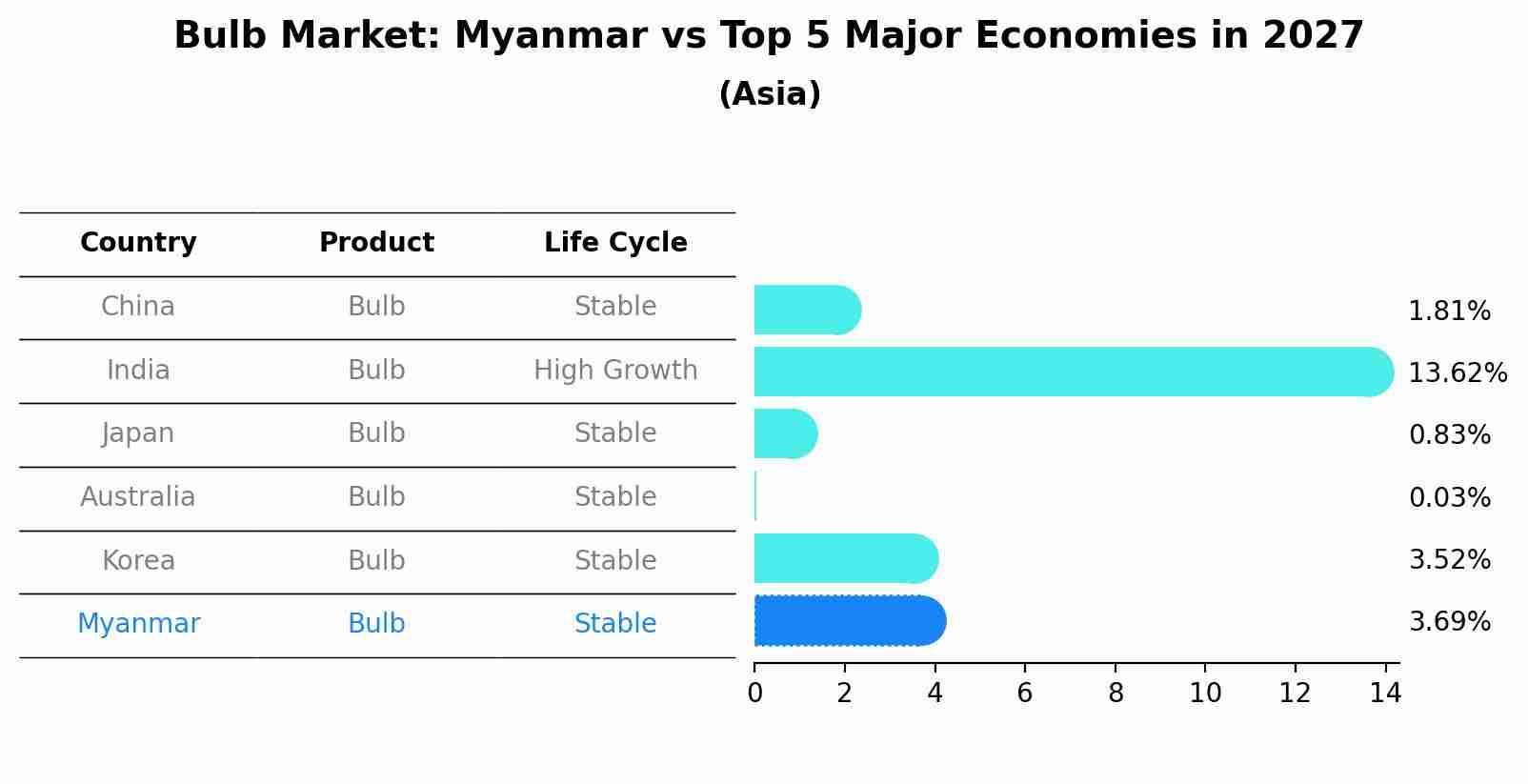Myanmar Bulb Market (2025-2031) Outlook | Growth, Industry, Revenue, Companies, Trends, Analysis, Share, Value, Size, Forecast
| Product Code: ETC258754 | Publication Date: Aug 2022 | Updated Date: Aug 2025 | Product Type: Market Research Report | |
| Publisher: 6Wresearch | Author: Ravi Bhandari | No. of Pages: 75 | No. of Figures: 35 | No. of Tables: 20 |
Myanmar Bulb Market Size Growth Rate
The Myanmar Bulb Market is likely to experience consistent growth rate gains over the period 2025 to 2029. From -8.18% in 2025, the growth rate steadily ascends to 10.79% in 2029.

Bulb Market: Myanmar vs Top 5 Major Economies in 2027 (Asia)
The Bulb market in Myanmar is projected to grow at a stable growth rate of 3.69% by 2027, highlighting the country's increasing focus on advanced technologies within the Asia region, where China holds the dominant position, followed closely by India, Japan, Australia and South Korea, shaping overall regional demand.

Myanmar Bulb Market Overview
Myanmar bulb market is witnessing growth due to urbanization and the rising demand for energy-efficient lighting solutions. Traditional incandescent bulbs are gradually being replaced by LED and CFL bulbs, which offer better energy efficiency and longer lifespan. The government`s initiatives to promote energy-saving technologies and the increasing awareness of the benefits of efficient lighting are significant factors contributing to the market`s expansion. The market is characterized by a mix of local and international players offering a range of lighting products.
Drivers of the market
The bulb market in Myanmar is driven by the ongoing transition from traditional incandescent bulbs to energy-efficient lighting solutions such as LED and CFL bulbs. This shift is fueled by the increasing awareness of energy savings and the long-term cost benefits of using energy-efficient lighting. Government initiatives and policies promoting energy efficiency and the replacement of old lighting systems in public and private sectors are also significant drivers. Moreover, the growth of urban areas and rising disposable incomes are leading to higher demand for modern lighting solutions.
Challenges of the market
The Myanmar bulb market struggles with issues related to quality control and market saturation with low-cost, low-quality imports. Consumers often opt for cheaper options, which may not meet safety standards, leading to a high rate of product failure and replacement. Additionally, the market is impacted by inconsistent electricity supply, which affects the longevity and performance of bulbs, thereby reducing consumer confidence in new products.
Government Policy of the market
The Myanmar government has been actively promoting energy-efficient lighting solutions as part of its broader energy conservation strategy. Policies include subsidies for energy-efficient bulbs, public awareness campaigns about the benefits of LED lighting, and regulations that phase out the use of inefficient incandescent bulbs. These measures are aimed at reducing energy consumption and lowering electricity costs for consumers.
Key Highlights of the Report:
- Myanmar Bulb Market Outlook
- Market Size of Myanmar Bulb Market, 2024
- Forecast of Myanmar Bulb Market, 2031
- Historical Data and Forecast of Myanmar Bulb Revenues & Volume for the Period 2021-2031
- Myanmar Bulb Market Trend Evolution
- Myanmar Bulb Market Drivers and Challenges
- Myanmar Bulb Price Trends
- Myanmar Bulb Porter's Five Forces
- Myanmar Bulb Industry Life Cycle
- Historical Data and Forecast of Myanmar Bulb Market Revenues & Volume By Type for the Period 2021-2031
- Historical Data and Forecast of Myanmar Bulb Market Revenues & Volume By Incandescent Bulbs for the Period 2021-2031
- Historical Data and Forecast of Myanmar Bulb Market Revenues & Volume By Fluorescent Bulbs for the Period 2021-2031
- Historical Data and Forecast of Myanmar Bulb Market Revenues & Volume By CFLs for the Period 2021-2031
- Historical Data and Forecast of Myanmar Bulb Market Revenues & Volume By Halogens for the Period 2021-2031
- Historical Data and Forecast of Myanmar Bulb Market Revenues & Volume By LEDs for the Period 2021-2031
- Historical Data and Forecast of Myanmar Bulb Market Revenues & Volume By Application for the Period 2021-2031
- Historical Data and Forecast of Myanmar Bulb Market Revenues & Volume By Lamps & Light Bulbs for the Period 2021-2031
- Historical Data and Forecast of Myanmar Bulb Market Revenues & Volume By Operation Theatre (OT Instruments) for the Period 2021-2031
- Historical Data and Forecast of Myanmar Bulb Market Revenues & Volume By Torchlights and Flashlights for the Period 2021-2031
- Historical Data and Forecast of Myanmar Bulb Market Revenues & Volume By Automobile Headlights for the Period 2021-2031
- Historical Data and Forecast of Myanmar Bulb Market Revenues & Volume By Mining Headgears for the Period 2021-2031
- Historical Data and Forecast of Myanmar Bulb Market Revenues & Volume By Others for the Period 2021-2031
- Myanmar Bulb Import Export Trade Statistics
- Market Opportunity Assessment By Type
- Market Opportunity Assessment By Application
- Myanmar Bulb Top Companies Market Share
- Myanmar Bulb Competitive Benchmarking By Technical and Operational Parameters
- Myanmar Bulb Company Profiles
- Myanmar Bulb Key Strategic Recommendations
Frequently Asked Questions About the Market Study (FAQs):
1 Executive Summary |
2 Introduction |
2.1 Key Highlights of the Report |
2.2 Report Description |
2.3 Market Scope & Segmentation |
2.4 Research Methodology |
2.5 Assumptions |
3 Myanmar Bulb Market Overview |
3.1 Myanmar Country Macro Economic Indicators |
3.2 Myanmar Bulb Market Revenues & Volume, 2021 & 2031F |
3.3 Myanmar Bulb Market - Industry Life Cycle |
3.4 Myanmar Bulb Market - Porter's Five Forces |
3.5 Myanmar Bulb Market Revenues & Volume Share, By Type, 2021 & 2031F |
3.6 Myanmar Bulb Market Revenues & Volume Share, By Application, 2021 & 2031F |
4 Myanmar Bulb Market Dynamics |
4.1 Impact Analysis |
4.2 Market Drivers |
4.2.1 Increasing demand for energy-efficient lighting solutions in Myanmar |
4.2.2 Government initiatives promoting the use of LED bulbs |
4.2.3 Growth in construction and infrastructure development projects in Myanmar |
4.3 Market Restraints |
4.3.1 Limited awareness and adoption of LED technology in rural areas |
4.3.2 High initial cost of LED bulbs compared to traditional lighting options |
5 Myanmar Bulb Market Trends |
6 Myanmar Bulb Market, By Types |
6.1 Myanmar Bulb Market, By Type |
6.1.1 Overview and Analysis |
6.1.2 Myanmar Bulb Market Revenues & Volume, By Type, 2021-2031F |
6.1.3 Myanmar Bulb Market Revenues & Volume, By Incandescent Bulbs, 2021-2031F |
6.1.4 Myanmar Bulb Market Revenues & Volume, By Fluorescent Bulbs, 2021-2031F |
6.1.5 Myanmar Bulb Market Revenues & Volume, By CFLs, 2021-2031F |
6.1.6 Myanmar Bulb Market Revenues & Volume, By Halogens, 2021-2031F |
6.1.7 Myanmar Bulb Market Revenues & Volume, By LEDs, 2021-2031F |
6.2 Myanmar Bulb Market, By Application |
6.2.1 Overview and Analysis |
6.2.2 Myanmar Bulb Market Revenues & Volume, By Lamps & Light Bulbs, 2021-2031F |
6.2.3 Myanmar Bulb Market Revenues & Volume, By Operation Theatre (OT Instruments), 2021-2031F |
6.2.4 Myanmar Bulb Market Revenues & Volume, By Torchlights and Flashlights, 2021-2031F |
6.2.5 Myanmar Bulb Market Revenues & Volume, By Automobile Headlights, 2021-2031F |
6.2.6 Myanmar Bulb Market Revenues & Volume, By Mining Headgears, 2021-2031F |
6.2.7 Myanmar Bulb Market Revenues & Volume, By Others, 2021-2031F |
7 Myanmar Bulb Market Import-Export Trade Statistics |
7.1 Myanmar Bulb Market Export to Major Countries |
7.2 Myanmar Bulb Market Imports from Major Countries |
8 Myanmar Bulb Market Key Performance Indicators |
8.1 Average electricity consumption per capita in Myanmar |
8.2 Number of government-led programs promoting energy-efficient lighting |
8.3 Percentage of construction projects incorporating LED lighting technologies |
8.4 Household income levels in urban and rural areas |
8.5 Number of retail outlets selling LED bulbs across Myanmar |
9 Myanmar Bulb Market - Opportunity Assessment |
9.1 Myanmar Bulb Market Opportunity Assessment, By Type, 2021 & 2031F |
9.2 Myanmar Bulb Market Opportunity Assessment, By Application, 2021 & 2031F |
10 Myanmar Bulb Market - Competitive Landscape |
10.1 Myanmar Bulb Market Revenue Share, By Companies, 2024 |
10.2 Myanmar Bulb Market Competitive Benchmarking, By Operating and Technical Parameters |
11 Company Profiles |
12 Recommendations |
13 Disclaimer |
- Single User License$ 1,995
- Department License$ 2,400
- Site License$ 3,120
- Global License$ 3,795
Search
Related Reports
- Portugal Electronic Document Management Market (2025-2031) | Strategy, Consumer Insights, Analysis, Investment Trends, Opportunities, Growth, Size, Share, Industry, Revenue, Segments, Value, Segmentation, Supply, Forecast, Restraints, Outlook, Competition, Drivers, Trends, Demand, Pricing Analysis, Competitive, Strategic Insights, Companies, Challenges
- France Electronic Document Management Market (2025-2031) | Strategy, Consumer Insights, Analysis, Investment Trends, Opportunities, Growth, Size, Share, Industry, Revenue, Segments, Value, Segmentation, Supply, Forecast, Restraints, Outlook, Competition, Drivers, Trends, Demand, Pricing Analysis, Competitive, Strategic Insights, Companies, Challenges
- Portugal Occupational Health & Safety Services Market (2025-2031) | Strategy, Consumer Insights, Analysis, Investment Trends, Opportunities, Growth, Size, Share, Industry, Revenue, Segments, Value, Segmentation, Supply, Forecast, Restraints, Outlook, Competition, Drivers, Trends, Demand, Pricing Analysis, Competitive, Strategic Insights, Companies, Challenges
- Netherlands Occupational Health and Safety Services Market (2025-2031) | Strategy, Consumer Insights, Analysis, Investment Trends, Opportunities, Growth, Size, Share, Industry, Revenue, Segments, Value, Segmentation, Supply, Forecast, Restraints, Outlook, Competition, Drivers, Trends, Demand, Pricing Analysis, Competitive, Strategic Insights, Companies, Challenges
- Belgium and Luxembourg Facility Management Market (2025-2031) | Strategy, Consumer Insights, Analysis, Investment Trends, Opportunities, Growth, Size, Share, Industry, Revenue, Segments, Value, Segmentation, Supply, Forecast, Restraints, Outlook, Competition, Drivers, Trends, Demand, Pricing Analysis, Competitive, Strategic Insights, Companies, Challenges
- Russia Women Intimate Apparel Market (2025-2031) | Strategy, Consumer Insights, Analysis, Investment Trends, Opportunities, Growth, Size, Share, Industry, Revenue, Segments, Value, Segmentation, Supply, Forecast, Restraints, Outlook, Competition, Drivers, Trends, Demand, Pricing Analysis, Competitive, Strategic Insights, Companies, Challenges
- Africa Chocolate Market (2025-2031) | Size, Share, Trends, Growth, Revenue, Analysis, Forecast, industry & Outlook
- Global Hydroxychloroquine And Chloroquine Market (2025-2031) | Industry, Trends, Size, Outlook, Growth, Value, Companies, Revenue, Analysis, Share, Forecast
- Saudi Arabia Plant Maintenance Market (2025-2031) | Industry, Size, Growth, Revenue, Value, Companies, Forecast, Analysis, Share & Trends
- Taiwan Electric Truck Market (2025-2031) | Outlook, Industry, Revenue, Size, Forecast, Growth, Analysis, Share, Companies, Value & Trends
Industry Events and Analyst Meet
Our Clients
Whitepaper
- Middle East & Africa Commercial Security Market Click here to view more.
- Middle East & Africa Fire Safety Systems & Equipment Market Click here to view more.
- GCC Drone Market Click here to view more.
- Middle East Lighting Fixture Market Click here to view more.
- GCC Physical & Perimeter Security Market Click here to view more.
6WResearch In News
- Doha a strategic location for EV manufacturing hub: IPA Qatar
- Demand for luxury TVs surging in the GCC, says Samsung
- Empowering Growth: The Thriving Journey of Bangladesh’s Cable Industry
- Demand for luxury TVs surging in the GCC, says Samsung
- Video call with a traditional healer? Once unthinkable, it’s now common in South Africa
- Intelligent Buildings To Smooth GCC’s Path To Net Zero













